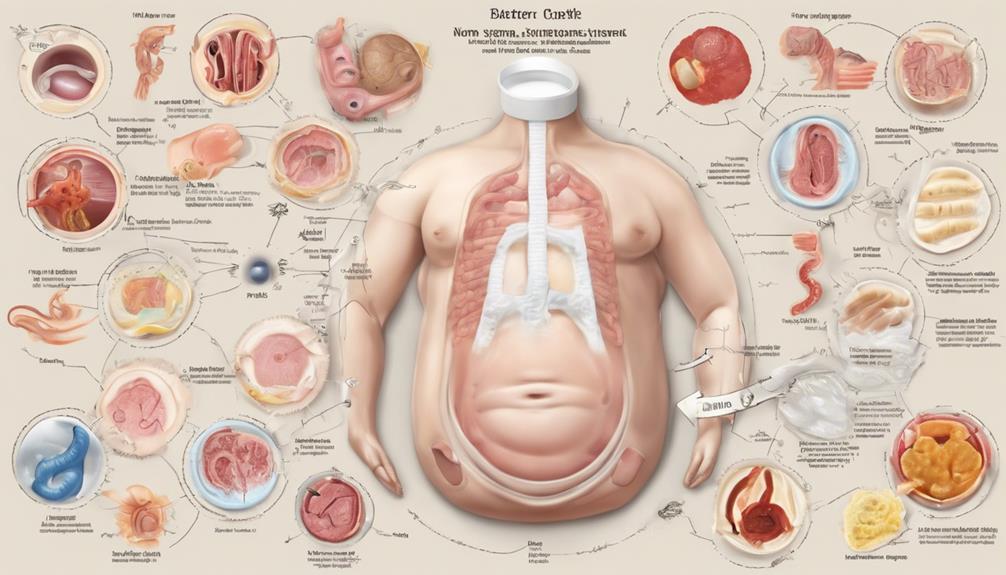Wondering what the role of a Newborn Care Specialist is? Essentially, they’re akin to baby whisperers for the first few months. By calming tears and setting up beneficial routines, these experts offer vital assistance to infants and their exhausted parents.
But that's just the tip of the iceberg. So, what exactly are the secrets behind their expertise?
Key Takeaways
- Provides hands-on care and guidance for newborns and families.
- Offers support with feeding, sleep habits, and routines.
- Assists parents with newborn care, emotional support, and bonding.
- Organizes supplies, maintains nurseries, and helps with light household tasks.
Responsibilities of a Newborn Care Specialist
As Newborn Care Specialists, we provide essential hands-on care and guidance to newborns and their families, guaranteeing the best support during this critical time. Our responsibilities encompass establishing routines, offering overnight care, assisting with feeding, and helping with sleep habits.
We focus on providing around-the-clock or daytime support for up to 3-4 months, making sure that both the newborn and parents receive the necessary care and attention. We acknowledge the importance of supporting parents in their journey, which is why we assist with bath time, provide extra support when needed, and concentrate on fostering the bond between the newborn and the family.
Our role goes beyond just physical care; we help parents heal faster post-birth, reduce the risk of postpartum mood disorders, and guarantee that the newborn receives the best care and attention. By offering guidance, support, and expertise, we aim to create a nurturing environment where both the newborn and the family can thrive.
Services Provided by a Newborn Care Specialist

Providing essential care and guidance to newborns and their families, a Newborn Care Specialist offers a range of services to guarantee the well-being and development of both the baby and parents. These specialists provide overnight care, assisting with feeding, diaper changes, and soothing the baby to sleep. They play a vital role in establishing routines and offering support with sleep training to promote healthy habits for the baby and much-needed rest for the parents.
Also, Newborn Care Specialists offer valuable advice on feeding schedules, bathing techniques, and essential developmental milestones.
In addition to practical care, these specialists provide emotional support and reassurance to new parents, helping them navigate the challenges of early parenthood with confidence. With specialized training in areas such as lactation consulting and sleep conditioning, Newborn Care Specialists are equipped to address common newborn issues like reflux promptly. Through their expertise and compassionate approach, these professionals make sure that families receive thorough support during the important early stages of their child's life.
Support Offered to New Parents
New parents can rely on the invaluable support and expertise of Newborn Care Specialists to navigate the challenges and uncertainties of caring for their newborn. These specialists offer a range of support to assist parents in this new journey:
- Establishing Routines: Newborn Care Specialists help parents set up effective routines, especially in the demanding early weeks following the birth. This guidance can be critical in creating a sense of stability for both the baby and the parents.
- Feeding Support: They provide valuable assistance and advice on feeding, whether it's breastfeeding, formula feeding, or a combination of both. This support safeguards that the newborn is well-fed and thriving.
- Sleep Habits Guidance: Newborn Care Specialists offer strategies and tips to help parents manage their baby's sleep habits. By establishing healthy sleep routines, they contribute to a more restful environment for both the baby and the parents.
Importance of Newborn Care Specialists

The important role of Newborn Care Specialists can't be overstated in providing essential support and guidance to new parents in managing the complexities of newborn care. As NCS, we play a critical part in assisting with various aspects of baby care, including breastfeeding techniques, establishing baby routines, and ensuring proper feeding and sleep schedules.
Our expertise in baby development allows us to offer valuable insights into creating a nurturing environment for newborns. Additionally, we're trained to provide emotional support, especially concerning postpartum support for mothers experiencing depression and anxiety. By identifying signs early on and connecting parents with the necessary resources, we help foster a healthy and supportive atmosphere for the entire family.
Through our guidance and knowledge, we aim to alleviate the stress and uncertainties that often come with caring for a newborn, empowering parents to navigate this new chapter with confidence and reassurance.
Duties Beyond Baby Care
Engaging with families in a holistic approach, Newborn Care Specialists extend their support beyond basic baby care duties to encompass a range of essential household tasks and personalized assistance to aid parents in their newborn journey.
- Organizing Supplies: Newborn Care Specialists assist in organizing baby supplies, ensuring that everything is readily accessible for the parents to use efficiently.
- Maintaining Nursery: They take charge of keeping the nursery tidy and well-organized, creating a peaceful and functional space for the baby and parents.
- Light Household Chores: In addition to baby-related chores, these specialists may also help with light household tasks such as tidying up common areas or preparing simple meals, allowing parents to focus on bonding with their newborn.
Frequently Asked Questions
Is a Newborn Care Specialist Worth It?
Absolutely, a newborn care specialist is worth it for new parents. They provide invaluable guidance, support, and expertise in newborn care, leading to more restful nights and a smoother postpartum recovery. Investing in their services can greatly enhance the parenting experience.
What Is the Difference Between a Nanny and a Newborn Care Specialist?
We provide care tailored to newborns, focusing on feeding, changing, bathing, and sleep routines. Nannies, on the other hand, care for older children, engaging in activities like homework help, outings, and bedtime routines.
What Is the Difference Between a Newborn Care Specialist and a Doula?
We support mothers uniquely. Newborn Care Specialists focus on baby care aspects like feeding and sleep routines. Doulas provide emotional and physical support to mothers during and after childbirth. Both roles are crucial in nurturing families.
What Is the Role of Newborn Care?
In our role, we provide essential care and guidance to newborns and parents, establishing routines, aiding with feeding, and promoting healthy sleep habits. Our support, offered around the clock, helps families rest, heal, and bond.
Conclusion
To sum up, Newborn Care Specialists play a crucial role in supporting parents and caring for newborns in their early months of life. They offer valuable guidance, expertise, and hands-on care to help families navigate the challenges of newborn care.
One interesting statistic to note is that the demand for NCSs has been steadily increasing, with a 48% growth in job opportunities expected by 2029 according to the Bureau of Labor Statistics.
Their dedication and expertise make a significant impact on the well-being of both babies and parents.










